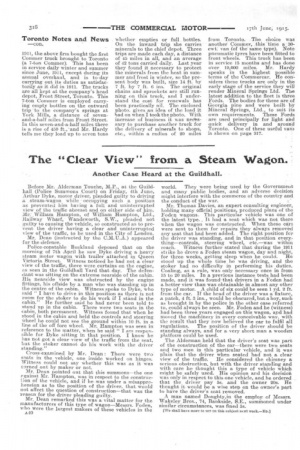The "Clear View" from a Steam Wagon.
Page 14

If you've noticed an error in this article please click here to report it so we can fix it.
Another Case Heard at the Guildhall.
Before Mr. Alderman Touche, M.P., at the Guildhall (Police Summons Court) on Friday, 4th Rine, Arthur Dyke, motor driver, pleaded guilty to driving a .steam-wagon while -.occupying such a position
as prevented him having a full and uninterrupted view of the traffic abreast and on either side of him. Mre.William Hampton, of William Hampton, Ltd.,
Railway Wharf, Wandsworth, S.W., pleaded not guilty to causing the vehicle, 80 constructed as to preveiat the driver having a clear and uninterrupted view of the traffic, to be used in the City of London.
Mr. Dean (instructed by the (3.M.U.A.) appeared for the defence.
Police-constable Buckland deposed that on the morning of 7th April he saw Dyke driving a heavy steam motor wagon with trailer attached in Queen Victoria Street. Witness noticed he had not a clear view of the traffic, there were curtains on the engine, as seen in the Guildhall Yard that day. The defendant was sitting on the extreme nearside of the cabin. His nearside view was obstructed by the engine fittings, his offside by a man who was standing up in the centre of the cabin. Witness spoke to Dyke, who said " I have to drive in this position as there is net room for the stoker to do his work if I stand in the cabin." He further said he had never been told to stand up in the cabin. There were two seats in the cabin, both permanent. Witness found that when he stood in the -cabin and held the controls and steering Wheel he could not see the ground within 10 ft. in a line of the off fore wheel. Mr. Hampton was seen in reference to the matter, when he said " I aen responsible for Dyke sitting in that position. I know he. has not got a clear view of the traffic from the seat, but the stoker cannot do his work with the driver s tanding. "
Cross-examined by Mr. Dean : There were two Seats in the vehicle, one inside worked on hinges. Witness could not say whether this was as it was turned out by maker or not. Mr. Dean pointed out that this summons—the one gainst Mr. Hampton, was in respect to the construction of the vehicle, and if he was under a misapprehension as to the position of the driver, that would not affect the question of construction—that was the reason for the driver pleading guilty. Mr. Dean remarked this was a vital matter for the nsanufacturers of this type of wagon—Messrs. Foden, who were the largest makers of these vehicles in the A40 world. They were being used by the Government and many public bodies, and an adverse decision might interfere with the commerce of the country and the conduct of the war.
Mr. Thomas Davies, an expert consulting engineer, holding many official positions, produced plans of the Foden wagons. This particular vehicle was one of the latest type... It had a seat which was not there 'when the wagon was constructed. When these care were sent to them for repairs they always removed any seat that had been added. The right position for the driver was standing, and in that position everything—controls, steering wheel, etc.—was within reach. Witness further stated that during the 19-11 stiike he drove a Foden steam wagon, day and night, for three weeks, getting sleep When he could. He stood up the whole time he was driving, and the stoker had no difficulty in performing his duties. Coaling, as a rule, was only necessary once in from 15 to 20 miles. In a previous instance tests had been made, and it was found that drivers in a Foden had a better view than was obtainable in almost any other type of motor. A child of six could be seen 1 yd. 2 ft. from the car. If the head .of the driver was a fixture, a patch, 4 ft. 3 ins., would be obscured, but a boy, such as brought in by the police in the other case referred to, could always be seen. Mr. Foden and he (witness) had been three years engaged on this wagon, and'had moved the machinery in every conceivable way, with the result that they now believed the car to fulfil all regulations. The position of the driver should be standing always, and for a very short man a wooden platform could be used.
The Alderman held that the driver's seat was part of the construction of the car—there were two seats and two men in this particular vehicle, and it was plain that the driver when seated had not a clear view of the traffic. He considered the chimney a serious obstruction, but with the driver standing and with care he thought this a type of vehicle which might be safely used. His opinion and his decision was only in respect to this one vehicle, and he ordered that the driver pay 5s. and the owner 20s. He thought it would be a wise step on the owner's part to have the driver's seat removed.
A man named Doughty,in the employ of Messrs. Wakeley Bros. 74, 13ankside, SE., summoned under similar circumstances, was fined Ss.
[We shall have more to say on this subject next week.—En.)






















